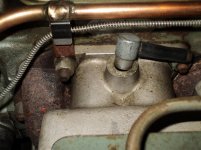My 1960 Series 1 3000 has three fixtures mounted atop the intake manifold. Their purpose is a mystery. Each of these fittings (see attached photo) plugs into the cast-in boss found on these manifolds between each of the three intake manifold entries to the head. I've seen pictures of these bosses both with holes (I assume they don't penetrate into the manifold) and without holes. In my case, each of these holes has a 5/8" diameter fitting with an attached tube projecting from one side. In each case this tube has a small section of rubber hose slipped over it, the hose blocked at the other end by a small bolt. The fittings each project about 5/8" above the manifold, The base is 9/16" in diameter, 3/8" long, and appears to be a slight taper. The bottom of the hole in the manifold has two 3/16" holes each appearing to be angled into the manifold, one toward the cylinder at right, one to the cylinder at left. The former owner, his mechanic and the person who restored this car profess no knowledge of these fittings. The only thing vaguely resembling might be the "balance tube" seen on pictures of tri-carbs. This is not a tri-carb. Also, this car has an aftermarket stainless steel exhaust system that produces a pronounced exhaust popping under deceleration, and I suspect this is enhanced by the communication that exists via the holes into the manifold. I intend to attempt to plug those holes and reinstall the fitting shown. But the question is, what do we have here?



 Hi Guest!
Hi Guest!

 smilie in place of the real @
smilie in place of the real @
 Pretty Please - add it to our Events forum(s) and add to the calendar! >>
Pretty Please - add it to our Events forum(s) and add to the calendar! >> 





